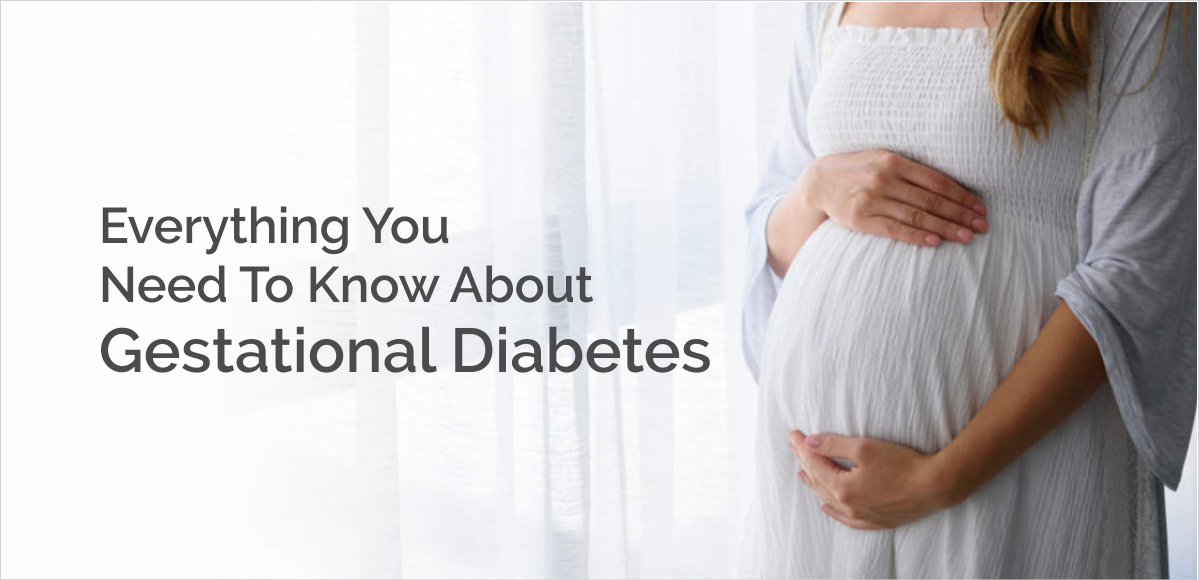

What is gestational diabetes?
Gestational diabetes is when a pregnant woman has high blood sugar levels. It is not gestational diabetes if the diabetes was present before pregnancy. Gestational Diabetes Mellitus (GDM) or gestational diabetes can occur during pregnancy.
After delivery, a few women with gestational diabetes are at high risk of developing type 2 diabetes. Even among those women whose sugar levels become normal post-delivery, there are chances of getting type-2 diabetes in the near or distant future.
Although gestational diabetes often goes away after the birth of your baby, it is advisable to be aware of the increased risk of type 2 diabetes and take steps to prevent it.
In the United States, 2% to 10% of pregnancies are affected by gestational diabetes every year. Currently, gestational diabetes is the most common medical complication of pregnancy, and the prevalence of undiagnosed hyperglycaemia in young women is on the rise.
What are the signs and symptoms of gestational diabetes?
Diabetes, as a disease, is not easy to detect and can exist without any symptoms. Gestational diabetes can also manifest as innocuous symptoms. Gestational diabetes has symptoms like those often seen in diabetes.
Common symptoms are:
- Dry mouth - The need to keep drinking a few sips of water.
- Fatigue - The general feeling of tiredness throughout the day, even with adequate rest.
- Extreme thirst - The need to consume more water than one usually does.
- Increased frequency of urination - Irrespective of water intake, there is a recurrent desire to urinate.
- Blurred vision - The unexplained blurring of sight without the need for prescription glasses.
- Fungal infections - Recurrent fungal infections at various parts of the body or lesions that do not disappear despite treatment.
What are the risks to the pregnancy?
Gestational diabetes poses a risk to both the unborn child and the pregnant woman.
Some of the immediate risks for the mother are:
- Increased need for caesarean section
- Disproportionate amniotic fluid
- Polyhydramnios, increase in amniotic fluid.
- Oligohydramnios, decrease in amniotic fluid.
- 3. Preeclampsia, high blood pressure for the mother
Some immediate risks for the unborn foetus are:
- Stillbirth
- Respiratory distress syndrome due to developed lungs
- Macrosomia – larger than normal sized baby
- Blood sugar levels and their complications
- Neonatal hypoglycaemia – decreased blood glucose levels in the baby
- Hyperinsulinemia – increased insulin levels in the baby’s blood
Gestational diabetes during any pregnancy poses some health risks in the future too. For the mother, there is an increased chance that she will have GDM in her future pregnancy. The woman may also develop Type 2 Diabetes after the pregnancy. For the child, there is a risk of suffering from diabetes during the later stages of life. The child has an increased chance of being obese.
How is gestational diabetes diagnosed?
Women with any one or more of these conditions are at a higher risk of GDM. Hence, it’s important to screen them to aid the early diagnosis of gestational diabetes mellitus.
- Obesity (before pregnancy)
- History of diabetes in a related family member
- PCOS (Poly-Cystic Ovarian Syndrome)
- History of GDM during the previous pregnancy
- History of giving birth to a baby that weighed more than 9 pounds
- History of stillbirth or miscarriage during previous pregnancies
Routine screening is necessary if a pregnant woman shows any of the symptoms mentioned above. The diagnosis is Gestational Diabetes Mellitus if:
- Fasting Blood Sugar is greater than 95 mg/dl (blood sugar levels after 10 hours of fasting)
- Post-prandial Blood Sugar greater than 140 mg/dl (blood sugar levels 2 hours after consuming 75 grams of glucose)
- Random blood sugar levels are greater than 200 mg/dl
HbA1C readings are not as relevant because the number of red blood cells is increased during pregnancy.
When to consult a doctor?
It is recommended to consult a doctor before getting pregnant. It would be preferable to screen for the risk of diabetes or existing undetected diabetes. Early detection of diabetes will lead to better management of the condition. Well-controlled diabetes will decrease the chances of complications during pregnancy.
Consult a doctor and check for gestational diabetes if any of the symptoms mentioned above are present.
When to consult a diabetologist
Upon diagnostic confirmation of gestational diabetes, consult a diabetologist for its treatment and management.
Prevention of gestational diabetes
Here are a few changes you can make to your lifestyle to help prevent gestational diabetes during pregnancy.
Eat a healthy diet
A balanced diet is essential to any pregnancy. The right proportion of carbohydrates, proteins, and fats can keep the mother healthy. It is better to have slow-release carbohydrates. Avoid processed foods and refined sugar.
Exercise regularly
Since obesity increases the chances of gestational diabetes, physical activity around the house is essential to keep gestational diabetes at bay. Regular walking is a good exercise. Performing simple chores is also beneficial.
What is the management and treatment of gestational diabetes?
Treatment for gestational diabetes may include:
- Insulin for pregnant mothers with high levels of diabetes
- Medication for keeping blood sugar levels in control
- Dietary modifications
Gestational diabetes needs a special diet under the supervision of a qualified nutritionist. The diet must include enough nutrition for both the mother and the unborn child. Intake of sugar and carbohydrates must be in check, but not at the cost of nutrition.
Management of gestational diabetes also includes:
Regular monitoring of blood glucose levels
For this purpose, it is advisable to have a blood sugar monitoring kit at home. This is necessary to be able to check blood sugar levels at least three times a day, especially after meals. Due to medication and diet, there may be hypoglycemic episodes. Hypoglycemia is when blood sugar levels dip. Hypoglycemia can lead to dizziness, sweating and can even make a person unconscious.
Physical activity and weight control
It is important to remain active during this phase. No strenuous activity is to be performed. Follow basic walking and fitness routines as recommended by a doctor.
The treatment of Gestational Diabetes Mellitus can be managed if detected early. If any symptoms point towards GDM, it is recommended to consult a doctor immediately. If there is a diagnosis of GDM, consult a diabetologist and a dietician for the same. When gestational diabetes is treated and managed, the chances of having a normal delivery are greater.
